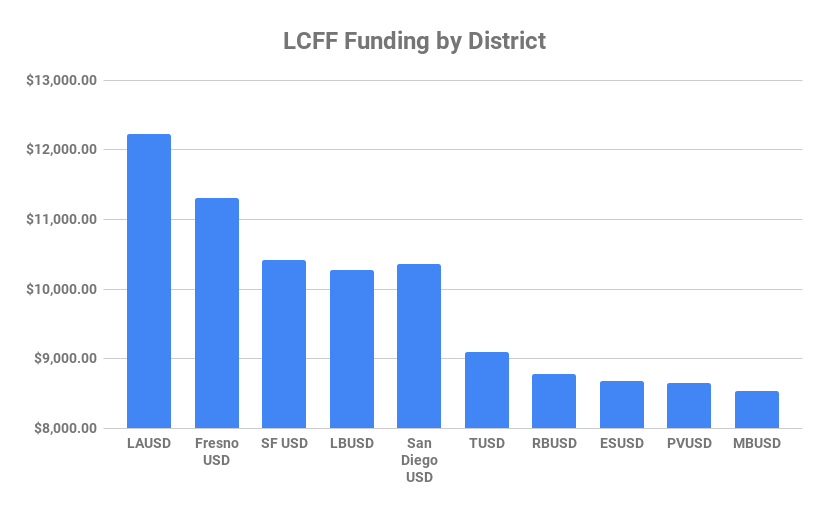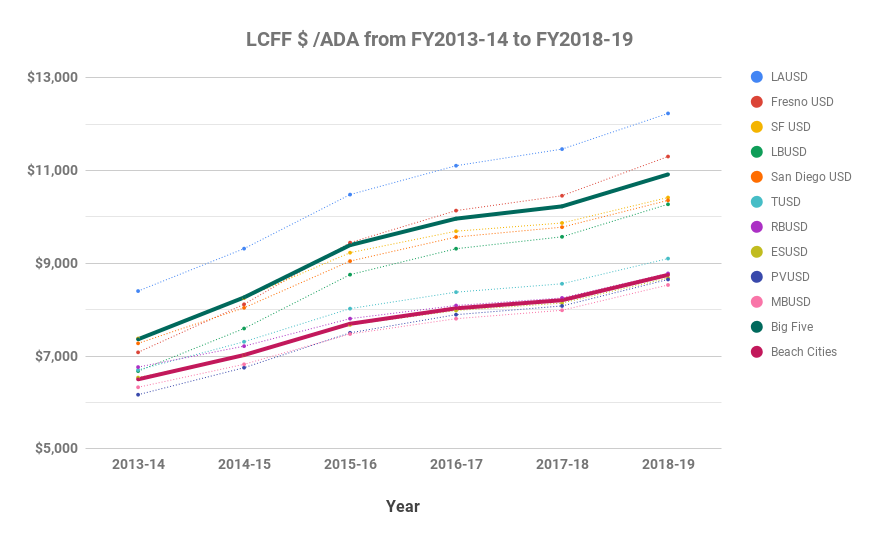No on Prop 13 — It’s Not Equitable
California’s Proposition 13 California School and College Facilities Bond sounds good on the surface, but has some major issues that cause concern for a large number of school districts. When I make decisions as a member of the school board, I base my choices on what is best for the kids. When I look at the details of the bond measure, I see that it is not good for the kids of the South Bay. In fact, it’s not good for the kids of hundreds of school districts across the state.
Proposition 13 was written for the benefit of large districts at the expense of smaller districts in more affluent areas. The “winners” of Prop 13 are the same districts that have been getting larger and larger shares of of the education budget with the Local Control Funding Formula (LCFF). The idea of LCFF is that school districts with “higher need” students get more money to invest in those students. School districts in California get 20% additional “Supplemental Funding” per student for students with higher needs — English Language Learners, children in poverty, and children in foster care. Additionally, when more than 55% of children in the district are in poverty, in foster care, or learning English, the district receives an extra 50% “Concentration Grant” of the base grant for each student beyond the 55% threshold.
What this has done is that it has given far more money to the largest districts (that have large numbers of disadvantaged students), as well as other districts in high poverty areas. I’m not saying that the students in these districts should not be getting more funding to offset the difficulties they encounter. The problem is the difference is growing larger, and starting to cause severe issues in the low poverty districts — and it remains to be seen if the extra money these districts have been getting is making any difference at all.
Here’s a chart showing the 2018-19 LCFF funding data gathered from the CDE website that shows the clear winners and losers when it comes to school funding. Imagine what our local districts could do with just $500 more per student. Maybe Manhattan Beach Unified would not be warning of layoffs and financial crisis if they were treated the same as LAUSD.

This is the data that is used to create the chart, showing the total LCFF funding per district, ADA (average daily attendance), what that works out to normalized to ADA, how each district compares on a per student basis to LAUSD, and then finally what each district would look like if they had the same 10,000 students. That number works well to compare each district to RBUSD which has just about that number. It is pretty obvious that the Beach Cities are far behind Southern California neighbors LAUSD and LBUSD. Do some searching and you will find the same thing across the state, with districts in low poverty areas such as Santa Clarita, Santa Barbara, San Jose, and many cities in the the greater San Francisco area also falling behind the behemoth districts like LAUSD, Fresno USD, and San Francisco USD.
| District | LCFF Funding | ADA | $/ADA | $ Below LAUSD | $ per 10,000 Students |
| LAUSD | $5,276,442,723 | 431,351 | $12,232 | — | $122,323,726 |
| Fresno USD | $758,307,550 | 67,087 | $11,303 | -$929.10 | $113,032,698 |
| San Francisco USD | $523,084,451 | 50,202 | $10,420 | -$1,812.77 | $104,196,001 |
| San Diego USD | $1,022,954,935 | 98,758 | $10,358 | -$1,874.19 | $103,581,835 |
| LBUSD | $730,408,551 | 71,093 | $10,274 | -$1,958.44 | $102,739,291 |
| TUSD | $205,723,291 | 22,599 | $9,103 | -$3,129.17 | $91,032,073 |
| RBUSD | $84,834,866 | 9,659 | $8,783 | -$3,449.21 | $87,831,592 |
| ESUSD | $29,312,270 | 3,376 | $8,684 | -$3,548.57 | $86,838,048 |
| PVUSD | $95,255,256 | 11,009 | $8,653 | -$3,579.67 | $86,527,016 |
| MBUSD | $54,724,739 | 6,413 | $8,534 | -$3,698.43 | $85,339,393 |
That’s a lot of data, and it gets even more interesting when you go back to the 2013-14 year when LCFF was first implemented. Below is a chart take from the same LCFF Report area of the CDE website. I used the attendance (ADA) numbers and total LCFF funding by district for the last six years and came up with the funding per student (ADA) for the five K-12 Beach City districts and for five of the largest districts in the state. Note that the original difference was far closer than it is now. If other districts were still getting one to two thousand dollars more per student than the beach city districts instead of three to four thousand more, then we would not be in the place we are where some districts can afford to pay their teachers more, buy more technology, and build more facilities while others are looking at layoffs, parcel taxes, and local bonds that will never be matched by the state.

LCFF has created this system where some districts have far greater funding already, and as I wrote about in the previous post, Proposition 13 uses similar methods to determine eligibility that gives these same districts first dibs on the bond money. What this means is that recent bonds passed by Beach City school districts (El Segundo, Hermosa Beach, Redondo Beach) or soon to be voted on will be paid for by the residents with no chance of matching funds from the state. This makes the local school bond twice as expensive for residents of these districts when compared to a bond passed by a district that will get matching funds from the state.
Note that the five large districts above have already passed over $30 Billion in bonds over the last 20 years, while the five local south bay districts above have accounted for less than $1.2 billion. Some of that local money was matched by the state, but that would be over with Prop 13.
There are arguments that schools in wealthier districts have been passing more bonds and thus getting more money than poorer districts. But Proposition 13 does not address this inequity either. It gives priority to districts with large numbers of unduplicated students, but if these districts cannot pass a bond measure in the first place, it does not matter where they are in line to receive matching funds. They have to pass a local bond before they can apply for money from the state. If the issue is that they need to be in the front of the line because they don’t have the ability to apply for matching funds, then address that issue. Provide easier ways to apply, let the state offer free assistance to districts on a need based schedule so that they can apply. Help these districts pass bond measures through support, or even allocate a percentage of a statewide bond for districts that need it the most without requiring the matching local bond. There are many ways to make sure districts who have been unable to pass bonds get money, while also not giving huge handouts to the districts that have already passed billions in bonds.
Prop 13 exacerbates the financial inequities caused by LCFF with winner and loser districts in California. LAUSD is a “winner” as they get $3,500 MORE per student than the average South Bay district, yet they still get high priority in bond funding. That’s just not fair.
